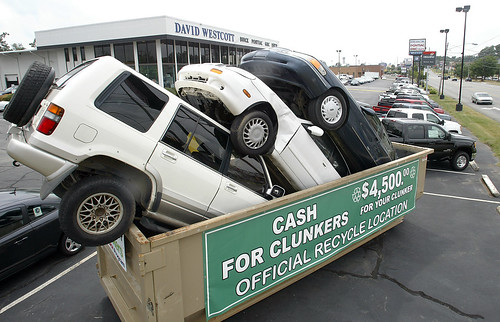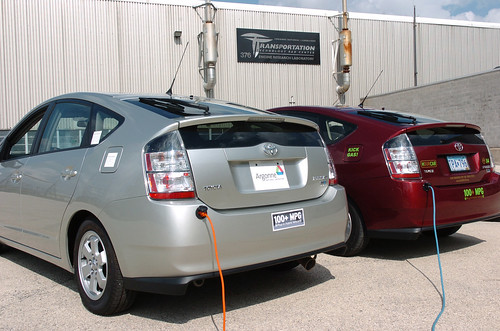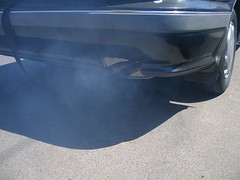(Source: AP Via Yahoo & Time)
 “Cash for clunkers” could have the same effect on global warming pollution as shutting down the entire country — every automobile, every factory, every power plant — for an hour per year. That could rise to three hours if the program is extended by Congress and remains as popular as it is now.
“Cash for clunkers” could have the same effect on global warming pollution as shutting down the entire country — every automobile, every factory, every power plant — for an hour per year. That could rise to three hours if the program is extended by Congress and remains as popular as it is now.
Climate experts aren’t impressed.
Compared to overall carbon dioxide emissions in the United States, the pollution savings from cash for clunkers do not noticeably move the fuel gauge. Environmental experts say the program — conceived primarily to stimulate the economy and jump-start the auto industry — is not an effective way to attack climate change.
“As a carbon dioxide policy, this is a terribly wasteful thing to do,” said Henry Jacoby, a professor of management and co-director of the Joint Program on the Science and Policy of Global Change at MIT. “The amount of carbon you are saving per federal expenditure is very, very small.”
Officials expect a quarter-million gas guzzlers will be junked under the original $1 billion set aside by Congress — money that is now all but exhausted.
Calculations by The Associated Press, using Department of Transportation figures, show that replacing those fuel hogs will reduce carbon dioxide emissions by just under 700,000 tons a year. While that may sound impressive, it’s nothing compared to what the U.S. spewed last year: nearly 6.4 billion tons (and that was down from previous years).
That means on average, every hour, America emits 728,000 tons of carbon dioxide. The total savings per year from cash for clunkers translates to about 57 minutes of America’s output of the chief greenhouse gas.
Likewise, America will be using nearly 72 million fewer gallons of gasoline a year because of the program, based on the first quarter-million vehicles replaced. U.S. drivers go through that amount of gas every 4 1/2 hours, according to the Department of Energy.
Time Magazine reports that initial data released by Department of Transportation, however, shows that so far cash for clunkers has been a green success. The clunkers averaged 15.8 m.p.g., compared with 25.4 m.p.g. for the new vehicles purchased, for an average fuel-economy increase of 61%. On the whole, American drivers are trading in inefficient trucks and SUVs for much more efficient passenger cars. Car manufacturers like Nissan are already retooling some models to improve their fuel economy so they can qualify for the credits. The early numbers were enough to convince California Senator Dianne Feinstein to go from criticizing cash for clunkers as too lax to supporting additional funding for the bill in the Senate. “This program has done much better than we ever thought it would for the environment,” she told reporters on Aug. 4.
It’s called the efficiency paradox: as we get more efficient at using energy — through less wasteful cars and appliances — the overall cost of energy goes down, but we respond by using more of it. In the case of cars, that means driving more. Ultimately our gas bill stays the same, but we spend more time on the road and pump the same amount of greenhouse-gas emissions into the atmosphere. The earth isn’t any better off.
To address the emissions problem directly, we need to look at fuel, not Fords: institute carbon taxes that raise the price of gas. We already know that higher gas prices discourage driving and reduce greenhouse-gas emissions — total vehicle miles traveled in the U.S. declined 3.6% in 2008 compared with the previous year, thanks largely to the sky-high price of gas for much of 2008. (The recession didn’t help, but sharp declines in driving began well before the bottom dropped out of the economy.) As gas prices have fallen in 2009, however, driving has begun to tick back up.
Click here to read the entire article.










